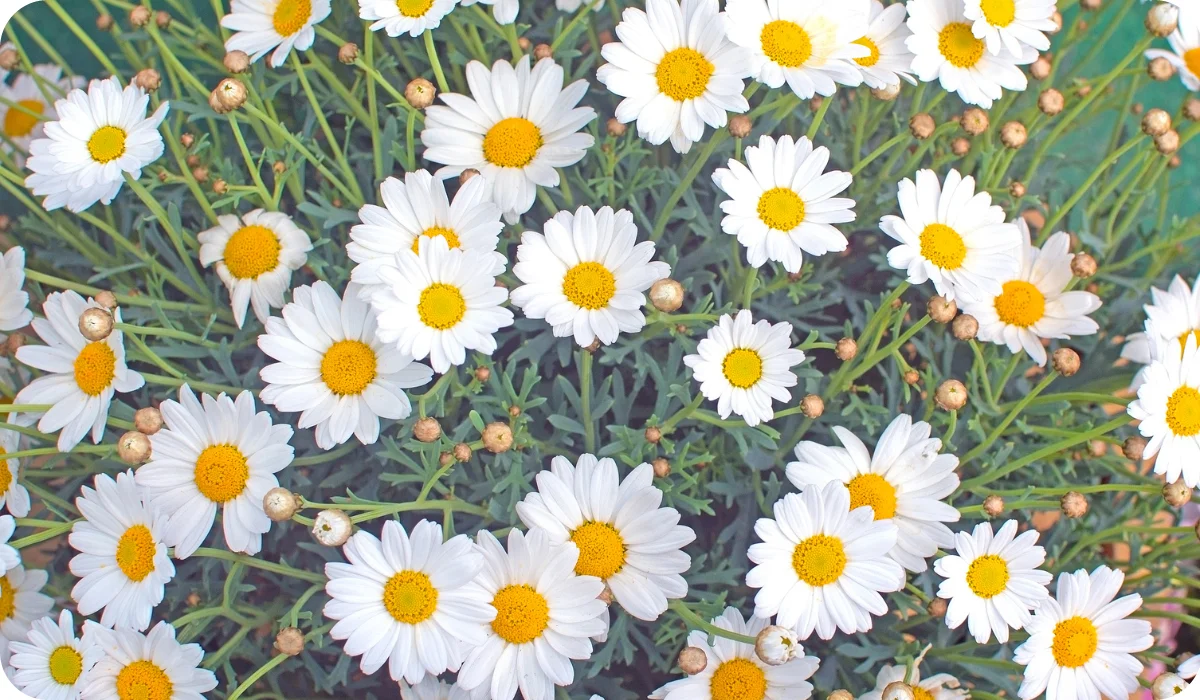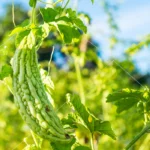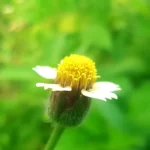Introduction to Daisy Flowers (Bellis Perennis)
The daisy flower, also known by its common name in India गुलबहार or डेज़ी in Hindi, is a beautiful and popular plant that can be found in gardens all around the world. It belongs to the daisy family and is scientifically known as the Bellis Perennis species. There are different types of daisies, each with its own unique characteristics and beauty. In this article, we will explore the various types of daisies, the process of planting them in your garden, the common colors they come in, their symbolic meanings, and the role of their petals in the overall structure of the flower.

General Information on Daisy Flowers What is a Daisy Flower?
A daisy flower, sometimes known by the simply “daisy”, is a popular and widely recognized herbaceous plant belonging to the Asteraceae family. Scientifically termed as Bellis Perennis, this beautiful flower is characterized by its small yet larger-than-average flower heads with white ray petals and a yellow center, often referred to as the “eye of the day”.
Daisy flowers, sometimes qualified as common daisies, are native to Europe and are celebrated for their simple, delicate beauty, and their resemblance to the white snow of Mount Shasta. They produce solitary flower heads, with some variations even boasting double flowers. The white flower, with its tubular flowers in the middle, is a sight to behold.
Daisies carry significant cultural and symbolic meaning across different cultures and time periods. They are often associated with purity, innocence, and new beginnings. In the language of flowers, daisies symbolize loyalty, love, and beauty. Their simple yet elegant appearance has made them a favorite choice for bouquets and flower arrangements, adding a touch of charm to any garden.
There are several types of daisies, each with its unique characteristics and growth requirements. Some of these include rare daisy species and flowers that grow lazy. Adding these flowers to your garden can create a beautiful landscape.
So, whether you’re growing this flower in your garden or using it to enhance your home decor, the daisy flower is an excellent addition. With its beautiful white petals and tubular flowers at the very center of the flower, the daisy, especially the ‘white ray’ variety, is a must-add to any flower enthusiast’s collection.
Meaning and Symbolism of Daisies
What if I told you that daisies are more than just visually appealing flowers? Daisies are often associated with innocence and purity. They represent a sense of freshness and a clean slate, symbolizing new beginnings and a pure heart.They carry with them a rich tapestry of meanings and symbolism that have evolved through centuries. Often associated with purity, innocence, and new beginnings, daisies hold a special place in cultural and historical contexts. Their open countenance seems to reflect a joyful embrace of life’s simpler pleasures, making them an embodiment of positivity and optimism.

Daisies as symbols of love and loyalty
In some cultures, daisies are regarded as symbols of love and loyalty. They are given as tokens of affection and are often used in wedding bouquets to represent the enduring bond between the couple.
Daisies as symbols of new beginnings
Due to their association with spring and their ability to bloom year after year, daisies are commonly seen as symbols of new beginnings and fresh starts. They inspire hope and optimism, reminding us that even after the harshest winters, beautiful things can emerge.
Planting and Caring for Daisies in your Garden
Choosing the right location
When planting daisies in your garden, it is important to choose a location that receives full sun or partial shade. Daisies thrive in well-draining soil, so avoid areas that are prone to waterlogging.
Preparing the soil
Before planting, prepare the soil by removing any weeds or debris. Loosen the soil to a depth of at least six inches and add organic matter, such as compost, to improve the soil’s fertility and drainage.
Sowing or transplanting daisy plants
You can either sow daisy seeds directly into the soil or start with transplants. If sowing seeds, scatter them lightly on the prepared soil and cover them with a thin layer of soil. Water the seeds regularly to keep the soil moist until germination occurs. If using transplants, dig a hole slightly larger than the root ball, place the plant in the hole, and gently firm the soil around it. Water the plant thoroughly after planting.
Seasonal Care for Daisies
Daisies require consistent, season-appropriate care to thrive and produce their vibrant blooms. Water your daisies regularly, ensuring the leaves and soil remain evenly moist but not waterlogged. Mulching around the plant base aids in moisture conservation and weed growth suppression. Deadheading the spent flowers and removing any withered leaves regularly will encourage continuous blooming and maintain a neat appearance. As the seasons change, particularly in colder climates, safeguard your daisies during winter by applying a protective layer of mulch around the plants.
Using Daisies in Your Garden
Ready to infuse your garden with a touch of classic charm and elegance? Daisies offer an ideal canvas for creating enchanting landscapes. Their versatility shines through as they seamlessly integrate into a variety of garden styles – from formal and structured designs to wild and carefree meadows. Whether you’re cultivating a haven for pollinators or aiming for a serene sanctuary, daisies can play a pivotal role in shaping your outdoor space.
How do daisy petals contribute to the overall structure of the flower?

The petals of a daisy flower are arranged in a unique way, contributing to its overall charm and appeal. Let’s take a closer look at the anatomy of a daisy petal:
The Anatomy of a Daisy Petal
A daisy petal consists of a flat, elongated shape with a pointed tip. It is usually white or colored, depending on the variety. The arrangement of petals forms what is known as a composite flower, with the central disc florets surrounded by ray florets.
Interesting Facts about Daisy Petals
Did you know that daisy petals have various uses beyond their visual appeal? Here are some interesting facts about daisy petals:
- Some cultures use daisy petals in herbal remedies for their soothing and anti-inflammatory properties.
- Daisy petals can be infused in oil or water to make fragrant and therapeutic products, such as lotions, creams, and essential oils.
- In some cuisines, daisy petals are used as garnishes or added to salads and teas for their unique flavor.
Uses of Daisy Petals
Daisy petals have been used in various traditional practices, including aromatherapy, skincare, and herbal medicine. They are believed to have calming and skin-nourishing properties, making them a popular ingredient in natural cosmetics and beauty products.
Daisies are versatile and captivating flowers that can brighten up any garden or floral arrangement. From their different types and colors to their intricate petal structure, daisies have a timeless appeal that continues to inspire gardeners and flower enthusiasts around the world.
Petal arrangement in a daisy flower
Daisy flowers have a composite structure with different types of flowers. Each flower head consists of numerous individual flowers, known as florets. The outer ray flowers have long petals that are white or in various colors, while the central disc flowers have tubular petals that conceal the reproductive parts of the flower.
The role of petals in attracting pollinators
The petals of a daisy play a crucial role in attracting pollinators, such as bees and butterflies. Their bright colors and delicate fragrance act as a signal, inviting these insects to visit the flower for nectar and pollen.
Types of Daisies: A Comprehensive Guide on Daisy Varieties
Explore the diverse world of daisies and discover the wide range of types and varieties available. From the classic Bellis perennis to the exotic African daisies, each type boasts unique characteristics and captivating beauty. Let’s delve into some of the most notable daisy species and explore their distinct features.
Exploring Bellis Perennis Type
Bellis perennis, also known as the common daisy or English daisy, is a beloved species that has become a symbol of spring. These daisies feature small, compact blooms with white petals and a vibrant yellow center. Bellis perennis is known for its low-growing habit, making it ideal for borders and ground covers. Their delicate flowers are a favorite amongst pollinators, attracting bees and butterflies to your garden.
Shasta Daisies
Shasta daisies, scientifically known as Leucanthemum x superbum, are popular perennial flowers that add a touch of elegance to any garden. These daisies boast large, daisy-like blooms with white petals and a vibrant yellow center. Shasta daisies are known for their exceptional longevity and ability to thrive in various climates. Their robust nature and stunning appearance make them a favorite choice among gardeners.
Understanding Different Daisy Varieties

Daisies come in a wide range of varieties, each with its own unique charm. Here are some of the most notable daisy varieties and uncover their distinctive characteristics.
African Daisies Plant
African daisies, scientifically known as Arctotis, are native to South Africa and are renowned for their vibrant and showy blooms. These daisies come in a variety of colors, including shades of orange, pink, and purple. African daisies are known for their ability to withstand hot and dry conditions, making them a perfect choice for arid climates.
Marguerite Daisies
Marguerite daisies, also known as Argyranthemum frutescens, are captivating flowers that originated in the Canary Islands. These daisies feature delicate white or yellow petals and a sunny yellow center. Marguerite daisies are prized for their long blooming period, adding a burst of color to your garden throughout the spring and summer months.
English Daisy
One of the most well-known types of daisies is the English Daisy. This daisy features white petals and a yellow center, creating a beautiful contrast in color. It is commonly found in lawns and gardens, adding a touch of elegance to any landscape.
The Moon Daisy
Also called the Ox-eye Daisy, is a prolific native flower found along roadsides and waste grounds. Known scientifically as Leucanthemum vulgare, it’s part of the Asteraceae family. This grassland plant, admired for its large, round white blooms from June to September, thrives in various habitats, contributing to wildlife preservation.
Bellis Perennis (Common Daisy)
The Bellis Perennis, also known as the Common Daisy, is a perennial flower with white petals and a yellow center. It is a small flower but adds a bright and cheerful touch to any garden. The Common Daisy is a hardy plant that can withstand various weather conditions, making it an ideal choice for gardeners.
Notable Species of Daisies – Different types of Daisies
Daisies encompass a vast array of species, each with its own captivating features. Let’s take a closer look at some notable species of daisies and uncover their unique qualities.
The Gloriosa Daisy and Last Chance Townsend Daisy
The Gloriosa daisy, also known as Rudbeckia hirta, is a striking perennial flower that showcases vibrant orange and yellow petals. This daisy species is renowned for its ability to attract butterflies and other pollinators, adding a lively touch to your garden. Another noteworthy species is the Last Chance Townsend daisy, scientifically known as Townsendia condensata. These daisies boast petite blooms with pink, purple, or white petals and are native to the western United States.
Swan River Daisy and Golden Marguerite Daisy
The Swan River daisy, scientifically known as Brachyscome iberidifolia, is a charming annual flower that originates from Australia. These daisies feature delicate blue, pink, or white petals and are known for their compact size and prolific blooming. Another captivating species is the Golden Marguerite daisy, scientifically known as Anthemis tinctoria. These daisies showcase bright yellow blooms and are valued for their ability to attract bees and butterflies.
Blue-Eyed African Daisy
The Blue-Eyed African daisy, scientifically known as Osteospermum, is a stunning flower that captivates with its vibrant colors. These daisies feature bold purple or blue petals with a contrasting yellow center. Blue-Eyed African daisies are known for their ability to thrive in full sun and well-draining soil, making them a popular choice for gardens and landscapes.
The World of Daisies: A Spectacle of Color
As if painted by the hand of a master artist, daisies exhibit a breathtaking array of colors. While white and yellow daisies are timeless classics, the spectrum extends to include hues that evoke a sense of wonder and surprise:
Yellow daisies
Yellow daisies exude warmth and happiness. They are commonly associated with the sun and are perfect for brightening up any space.
Pink daisies
Pink daisies are delicate and romantic. Their soft hue adds a feminine touch to gardens, making them an ideal choice for those who prefer a more gentle and subtle color.
Red, Purple, and Blue Daisies
Why restrict daisies to a monochromatic palette when they can dazzle in shades of red, purple, and blue? These bold colors inject a sense of drama and vibrancy into gardens, creating focal points that are impossible to ignore.
Daisy Petals and Their Colors
Imagine a canvas adorned with petals that speak a language of their own. Daisies come alive with a spectrum of petal colors, each carrying its own message. White petals symbolize innocence, yellow exudes joy, pink conveys admiration, and red ignites passion – an eloquent dialogue of emotions painted in petals.
Gerbera Daisies and Other Daisy Varieties
Understanding Gerbera Daisies
Prepare to be enchanted by the charisma of Gerbera Daisies. With their vibrant hues and bold presence, these blooms steal the spotlight in gardens and floral arrangements alike. Their large, daisy-like blossoms radiate positivity, making them an embodiment of cheerfulness and delight.
African Daisies
The spirit of Africa comes alive in African Daisies, each petal a testament to the continent’s vibrant soul. Their dazzling colors and intricate patterns mirror the landscapes from which they draw their inspiration. These blooms thrive across various climates, adding a touch of exuberance to any garden.
Marguerite Daisies
In the world of daisies, Marguerites stand as delicate emissaries of elegance. With their refined appearance and soft hues, they bring a sense of calm and tranquility to gardens. Their versatility allows them to grace formal settings as well as more relaxed landscapes.
FAQs People Also Ask about Daisy Flower (With Straight Answers)
Q: What is the common name for Bellis Perennis?
A: The common name for Bellis Perennis is daisy.
Q: Are All Daisies Chamomile Plants?
A: While it’s true that all chamomile plants fall under the daisy category, it’s important to note that the reverse is not the case – not every daisy can be classified as a chamomile plant.
Q: What are the different types of daisies?
A: There are various types of daisies, including oxeye daisies, painted daisies, and lawn daisies.
Q: What color are daisy flowers?
A: Daisy flowers can come in a variety of colors, including white, yellow, and sometimes even pink or red.
Q: What does a daisy symbolize?
A: Daisy flowers symbolize purity, innocence, and new beginnings.
Q: What are ray flowers in a daisy?
A: Ray flowers are the outermost petals of a daisy flower, which typically surround the disk flowers in the center.
Q: Where is the daisy native to?
A: The daisy is native to Europe, but it can now be found in many other parts of the world as well.
Q: What are the characteristics of a daisy flower?
A: Daisy flowers have showy flower heads with ray flowers surrounding the central disk flowers. They are herbaceous plants with beautiful white or yellow flowers.
Q: Are there any rare species of daisies?
A: Yes, there are some rare species of daisies that can be found in specific regions. However, the common daisy is widely cultivated and popular.
Q: Can daisies be grown as cut flowers?
A: Yes, daisies are often grown and used as cut flowers due to their attractive appearance and long-lasting nature.
Conclusion: The Beauty of Daisies
As we conclude our journey through the captivating world of daisy plants, we invite you to envision your garden as a canvas waiting to be adorned with their splendor. Daisies are not mere flowers; they are storytellers, messengers of emotion, and bearers of nature’s grace. By understanding their diversity, symbolism, and care requirements, you’re equipped to create landscapes that are not only visually stunning but also deeply meaningful.
The allure of daisies lies not only in their vibrant colors and exquisite forms, but also in their ability to connect us with the simple joys of life. Whether they’re gracing wedding bouquets, filling vases with cheer, or swaying gently in the breeze of a countryside garden, daisies continue to captivate our hearts and enrich our lives.
So, fellow garden enthusiasts, as you venture forth to nurture these floral wonders, remember that you’re partaking in a tradition that spans cultures, generations, and landscapes. Embrace the beauty of daisies, and let your garden become a sanctuary where their magic unfolds, inviting you to pause, appreciate, and celebrate the evergreen enchantment of these timeless blooms.
About our Web Store www.shehrikisaan.com
For a wide selection of fertilizers and soil amendments suitable for all these plants, we invite you to explore our esteemed webstore at www.shehrikisaan.com. Our webstore offers a comprehensive range of products designed to enhance the growth and vitality of your plants.
Whether you’re seeking specialized fertilizers, organic amendments, or premium-quality soil enhancers, our webstore is your one-stop destination. With our commitment to providing garden enthusiasts with top-notch products, you can trust us to cater to your gardening needs effectively. Visit www.shehrikisaan.com today and unlock the secret to flourishing plants.
Discover our Social Media Presence and web store. Choose your favourite platforms:
















